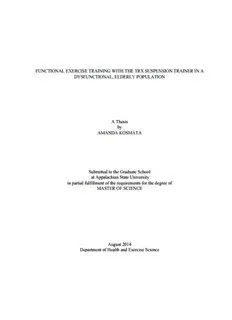
Functional Exercise Training With The TRX Suspension Trainer in a PDF
Preview Functional Exercise Training With The TRX Suspension Trainer in a
FUNCTIONAL EXERCISE TRAINING WITH THE TRX SUSPENSION TRAINER IN A DYSFUNCTIONAL, ELDERLY POPULATION A Thesis by AMANDA KOSMATA Submitted to the Graduate School at Appalachian State University in partial fulfillment of the requirements for the degree of MASTER OF SCIENCE August 2014 Department of Health and Exercise Science ! FUNCTIONAL EXERCISE TRAINING WITH THE TRX SUSPENSION TRAINER IN A DYSFUNCTIONAL, ELDERLY POPULATION A Thesis by AMANDA KOSMATA August 2014 APPROVED BY: Kevin A. Zwetsloot, Ph.D. Chairperson, Thesis Committee Edward K. Merritt, Ph.D. Member, Thesis Committee N. Travis Triplett, Ph.D. Member, Thesis Committee N. Travis Triplett, Ph.D. Interim Chairperson, Department of Health and Exercise Science Max C. Poole, Ph.D. Dean, Cratis Williams Graduate School ! Copyright by Amanda Kosmata 2014 All Rights Reserved ! Abstract FUNCTIONAL EXERCISE TRAINING WITH THE TRX SUSPENSION TRAINER IN A DYSFUNCTIONAL, ELDERLY POPULATION Amanda Kosmata B.A., Ohio Wesleyan University M.S., Appalachian State University Chairperson: Kevin A. Zwetsloot, Ph.D. Sarcopenia, the decrease in muscle strength due to the aging process, can lead to impairment in the neuromuscular system, falls and injury, decreased functionality in activities of daily living and decreased independence in the elderly population. Research has shown that resistance exercise training can help to slow, stop, and possibly reverse the process of sarcopenia. Less research has focused on functional training, or task-specific strength training used to improve functionality in activities of daily living. Functional training has been shown to be effective in improving ability and time in completing activities of daily living in an elderly population and that it may be more effective than resistance training alone. Much of the research done on using resistance exercise training to improve functionality has been done using traditional free weights and weight machines in a functional, independent elderly population. The dysfunctional, institutionalized elderly population is most in need of easily accessible, effective, and safe methods of iv! resistance exercise training to improve functionality in activities of daily living. The TRX suspension trainer is a unique modality of exercise that consists of two straps and handles that allow for the use of one’s own body weight as resistance and can be easily transported and used in several environments. Therefore, the purpose of this study was to determine if a functional exercise training program, using the TRX suspension system, would be effective in improving functionality in a dysfunctional, institutionalized elderly population. Subjects (n=3) performed an 8-week, progressive functional exercise training program that included exercises that mimic activities of daily living, using the TRX suspension system. Subjects were tested before exercise began, after 4 weeks of exercise, and after 8 weeks of exercise with the Berg Balance Scale, Timed Up and Go Test, Five-Timed Sit-to-Stand Test, Handgrip Strength assessment, and the SF-36 Survey. There was a significant change from 4-week- to post-testing in the sit-to- stand assessment in the Berg Balance Scale. Although only one outcome measure was found to be statistically significant, there were small, but clinically significant improvements in functionality of activities of daily living, and therefore, in quality of life for the participants. v! Acknowledgments I’d like to thank my committee chairperson, Dr. Kevin A. Zwetsloot, and my other committee members, Dr. N. Travis Triplett and Dr. Edward K. Merritt. Thanks to the Office of Student Research for the generous grants, which allowed us to conduct this research. Thank you to Deerfield Ridge for allowing us to train their residents. Finally, I’d like to thank the students who helped us with this study, including Lauren Carson, Joshua Warren, Madalyn File, and Victoria Roberts. v!i Dedication This thesis is dedicated to my mother, Debbie Kosmata. Without you, I never would have gotten this far. vi!i Table of Contents Abstract ............................................................................................................................... iv Acknowledgments .............................................................................................................. vi Dedication .......................................................................................................................... vii List of Tables ...................................................................................................................... ix Chapter 1 ............................................................................................................................. 1 Chapter 2 ............................................................................................................................. 4 Chapter 3 ........................................................................................................................... 10 Chapter 4 ........................................................................................................................... 15 Chapter 5 ........................................................................................................................... 20 References ......................................................................................................................... 37 Appendix A ....................................................................................................................... 43 Vita .................................................................................................................................... 47 vi!ii List of Tables Table 1. Handgrip Strength ............................................................................................... 33 Table 2. Five-Timed Repeated Sit-to-Stand ...................................................................... 33 Table 3. Timed Up and Go ................................................................................................ 33 Table 4. Berg Balance Scale .............................................................................................. 34 Table 5. SF-36 Survey ....................................................................................................... 36 ix! Chapter 1. Introduction Falls were the foremost cause of accidental death in 2007 in adults aged 65 and older (Henry-Sanchez, Kurichi, Xie, Pan, & Stineman, 2012). Furthermore, falls that don’t lead to death or serious debilitating injury cause increased fear, decreased mobility, deconditioning, and decreased functionality in activities of daily living (ADLs) which can contribute to more falls in older adults (Henry-Sanchez et al., 2012). Approximately 20-30% of the elderly population report debilitations in activities of daily living and mobility (Topinkova, 2008). Previous studies have demonstrated that balance and strength deficits contribute to disability in ADLs (Vermeulen, Neyens, van Rossum, Spreeuwenberg, & de Witte, 2011). As adults age, there is a decrease in functionality of ADLs and independence, both of which are directly related to physical fitness (Garatachea & Lucia, 2012). Many factors can lead to decreases in functionality, one of which is sarcopenia (Jang & Van Remmen, 2011). Sarcopenia is the loss of muscle mass and strength associated with the aging process (Muhlberg & Sieber, 2004; Yarasheski, 2003). The following futile cycle demonstrates the detrimental effects sarcopenia has on the aging population: Neuromuscular deficiency ! Sarcopenia ! Fall and Injury ! Hospitalization and Immobilization ! further Sarcopenia (Muhlberg & Sieber, 2004). Sarcopenia leads to problems with mobility and balance, which impairs gait performance and causes balance disorders (Muhlberg & Sieber, 2004). Difficulty with mobility can lead to more falls, decreases in functionality, disability, and death (Jang & Van Remmen, 2011). Resistance exercise is a potential means to prevent, stop, and reverse the futile cycle of sarcopenia. 1
